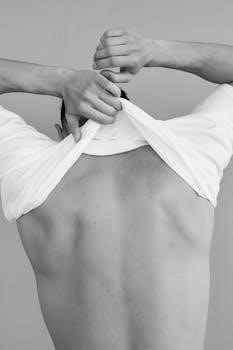Overview of Calculus by Jon Rogawski 4th Edition
Rogawski’s Calculus, 4th edition, provides a comprehensive exploration of single and multivariable calculus. It balances formal precision with conceptual understanding. The text is available in multiple formats, including an Early Transcendentals version.
Key Features of Rogawski’s Calculus 4th Edition
Jon Rogawski’s Calculus 4th Edition is celebrated for its ideal balance between formal rigor and conceptual clarity. This edition offers a rich collection of examples and exercises with graduated difficulty, reinforcing basic skills and advanced problem-solving techniques. It emphasizes the beauty and practical relevance of calculus in understanding the world. The text incorporates valuable lessons from Rogawski’s teaching experience, shaping a calculus text that builds strong computational skills. The book’s legacy continues through each new edition, maintaining its commitment to students’ understanding.

Availability of the Textbook
The 4th edition is available in multiple formats. These include physical copies like hardcover and loose-leaf versions. It is also accessible in digital formats, like PDFs, from various online sources.
Physical Copies: Hardcover and Loose-Leaf Versions

Rogawski’s Calculus, 4th Edition, is widely accessible in physical formats. Students and instructors can purchase the textbook in both hardcover and loose-leaf versions. The hardcover edition offers durability and is suitable for long-term use and reference. The loose-leaf version provides flexibility, allowing users to organize the chapters according to their course needs. These physical copies are available through major textbook retailers, college bookstores, and online vendors. Choosing between hardcover and loose-leaf depends on individual preferences for durability versus customizability. Both formats contain the same content.
Digital Formats: PDF Availability
The digital PDF version of Rogawski’s Calculus, 4th Edition, is a sought-after resource for students. While not always officially available for direct purchase due to copyright restrictions, students often seek PDF versions for convenience and cost savings. Some platforms may unofficially offer downloadable PDFs; however, users should be cautious of copyright infringement. Open Library is a potential source for borrowing a digital version. Digital formats provide accessibility across devices, making it a convenient study tool. Always ensure compliance with copyright laws when accessing digital textbooks.

Resources Available Online
Numerous online resources support problem-solving. Solution manuals and step-by-step solutions are widely accessible from various vendors. These assist students in understanding and mastering calculus concepts presented in Rogawski’s Calculus, 4th edition.
Solution Manuals and Step-by-Step Solutions
For Rogawski’s Calculus, 4th Edition, solution manuals offer detailed, step-by-step solutions to exercises, aiding comprehension. These resources can be found online, providing assistance for students working through problems. Such manuals often cover all chapters, presenting solutions in PDF or similar formats. They are designed to enhance understanding and problem-solving skills, supplementing the textbook content. Access to these solutions can significantly improve a student’s ability to grasp calculus concepts and apply them effectively. Various platforms offer these materials, supporting independent learning and exam preparation.
Online Problem-Solving Support
Numerous online resources provide problem-solving support for Rogawski’s Calculus, 4th Edition. These include forums, websites, and educational platforms where students can ask questions and receive assistance. Online communities often offer step-by-step explanations and alternative solution methods. Video tutorials and interactive tools may also be available. These resources help students overcome challenges and deepen their understanding of calculus concepts. They offer a collaborative learning environment, enhancing problem-solving skills and promoting academic success. Many platforms provide 24/7 assistance, ensuring students can access support whenever needed.

Jon Rogawski’s Legacy
Jon Rogawski’s legacy lives on through his commitment to presenting the beauty of calculus. His approach significantly impacted calculus textbook design. His work emphasizes understanding the role calculus plays in students’ broader understanding.
Rogawski’s Approach to Calculus Education
Jon Rogawski’s approach to calculus education emphasized a balance between formal precision and conceptual understanding. He aimed to present calculus as both a rigorous mathematical subject and a tool for understanding the wider world. Rogawski’s textbooks reflect his commitment to clarity and accessibility, making complex concepts understandable for students. His work highlights the beauty and importance of calculus, fostering a deeper appreciation for mathematics. Sadly, Jon Rogawski passed away in September 2011, but his legacy continues to inspire educators and students.
Impact on Calculus Textbook Design
Jon Rogawski’s calculus textbook design significantly impacted the field. His approach, which balanced formal precision with conceptual understanding, set a new standard. Rogawski emphasized clarity and accessibility, making calculus more approachable for students. His commitment to presenting the beauty and relevance of calculus influenced subsequent textbook designs. Rogawski’s work highlighted the importance of connecting calculus to real-world applications. His legacy continues to shape calculus education, inspiring educators to create engaging and effective learning materials. The integration of problem-solving techniques was also a key design element.

Authorship and Collaboration
The fourth edition of Rogawski’s Calculus involved collaboration. Colin Adams and Robert Franzosa joined Jon Rogawski as co-authors. Their combined expertise enhanced the textbook. This teamwork strengthened the content.
Co-authors: Colin Adams and Robert Franzosa
Colin Adams and Robert Franzosa collaborated with Jon Rogawski on the 4th edition of Calculus. Their involvement brought additional expertise and perspectives to the textbook. Adams and Franzosa are both accomplished mathematicians and educators. Their contributions enhanced the clarity, accuracy, and pedagogical effectiveness of the material. Together, they ensured the textbook remained a valuable resource for students. They helped maintain the book’s balance between rigor and accessibility. Their collaboration demonstrates a commitment to excellence in calculus education.

Content Coverage
Rogawski’s Calculus, 4th edition, covers both single and multivariable calculus. The textbook explores fundamental concepts, techniques, and applications. An Early Transcendentals version is also available. This version introduces transcendental functions earlier in the course.
Single and Multivariable Calculus
Rogawski’s Calculus, 4th Edition, offers a comprehensive treatment of both single and multivariable calculus. Single variable calculus covers limits, derivatives, integrals, and applications involving functions of one variable. Multivariable calculus extends these concepts to functions of several variables, including partial derivatives, multiple integrals, vector fields, and topics like line and surface integrals. The textbook is designed to provide students with a solid foundation in these core areas, preparing them for advanced studies in mathematics, science, and engineering. It includes numerous examples and exercises to reinforce understanding.
Early Transcendentals Version
The Early Transcendentals version of Rogawski’s Calculus, 4th Edition, introduces transcendental functions, such as exponential, logarithmic, trigonometric, and inverse trigonometric functions, earlier in the course. This approach allows students to encounter these functions and their applications sooner, providing a more integrated view of calculus concepts. It is designed for courses that prefer to cover these functions alongside algebraic functions from the beginning. This version helps students develop a deeper understanding of calculus by exposing them to a wider range of functions and applications throughout their learning journey.

Where to Download PDF Versions
Open Library is a reliable platform to potentially download the PDF version. Various online sources may offer downloads, but ensure legality and safety before downloading any PDF files from unofficial sources.
Open Library
Open Library stands out as a potential avenue for accessing the PDF version. It has a vast collection of over 1 million free e-books. Users may find the 4th edition available for borrowing or download, providing a convenient way to access the material digitally. Always ensure that any download from Open Library or other sources complies with copyright regulations. Check for the specific edition and version needed for course requirements. This platform aims to make knowledge accessible.

Supplementary Materials
A rich collection of examples and exercises, graduated by difficulty, teach basic skills and problem-solving techniques. These materials reinforce conceptual understanding, providing students with a comprehensive learning experience.
Examples and Exercises
The textbook features a rich collection of examples and exercises designed to enhance students’ grasp of calculus concepts. These exercises are carefully graduated in difficulty, starting with basic skill-building problems and progressing to more complex problem-solving scenarios. This approach allows students to gradually develop their abilities and confidence as they work through the material. The examples provide clear, step-by-step solutions to illustrate key techniques, while the exercises offer ample opportunity for practice and application. These resources are crucial for mastering calculus and developing a deeper understanding of its principles.

Formats
Rogawski’s Calculus, 4th edition, is available in various formats, including the Early Transcendentals version. This caters to different curricula and preferences. The availability in multiple formats ensures accessibility for all students.
Early Transcendentals
The Early Transcendentals version of Rogawski’s Calculus 4th Edition introduces transcendental functions earlier in the course. This approach allows students to work with exponential, logarithmic, and trigonometric functions sooner, providing a richer set of examples and applications throughout the calculus sequence. The Early Transcendentals format is designed to accommodate curricula that integrate these functions from the beginning. This version maintains the balance of formal precision and conceptual focus, ensuring students develop strong problem-solving techniques. It is widely available and supported by online resources.








































